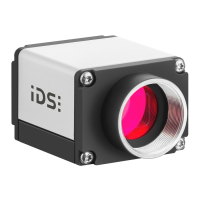© 2009 IDS Imaging Development Systems GmbH36
User Manual uEye Cameras V3.32
6.4 Reading out Partial Images
The camera sensors have defined resolutions which are given as the number of pixels (width x
height). However, for some applications it may be necessary to read out only a selected part of the
sensor area or to reduce the local resolution. For this purpose, the uEye cameras provide various
functions:
· Area of Interest (AOI)
· Binning (combining) pixels
· Subsampling (skipping) pixels
These functions reduce the amount of data to be transferred and thus allow you to increase the
frame rate considerably, depending on the camera model.
6.4.1 Area of Interest (AOI)
Using this function, you can set the size and position of an area of interest (AOI) within an image. In
this case, only data included in this AOI will be read out and transferred to the computer. The
smaller partial image enables the camera to use a higher frame rate.
For the maximum frame rates that can be obtained with a specific camera model using AOI, please
refer to the Specifications: Sensors chapter.
Figure 34: Camera AOI (Area of Interest)
Please note that, after defining an AOI, the resulting image may be darker if the camera
cannot maintain the originally set exposure time due to the increased frame rate.
6.4.2 Binning
Binning is a function that averages or adds multiple sensor pixels to obtain a single value. This
reduces the amount of data to be transferred and enables higher camera frame rates. The captured
image has a lower resolution but still the same field of view compared to the full-resolution image.
This mode can be used as a fast preview mode for high-resolution cameras.
Color binning, as performed by most color sensors, combines only pixels of the same color (see
also the Color Filter (Bayer Filter) chapter). For some monochrome sensors, the camera also
performs color binning, resulting in slight artifacts.
Most monochrome sensors and some color sensors combine neighboring Bayer pattern pixels; in
this case, the color information gets lost (mono binning).
With CCD sensors, binning makes the images brighter because the pixel values are added up. With

